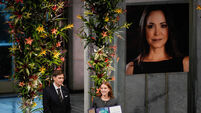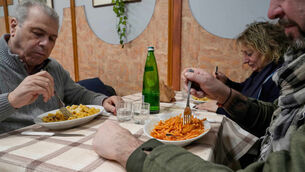Rare Michelangelo found in back room of museum
A rare Michelangelo drawing worth more than £6 million was discovered in a back room of a New York City design museum, museum officials said today.
‘‘To find a new drawing by Michelangelo is very exciting, but to find a drawing by him of a menorah and, moreover, in New York, is almost incredible,’’ said Sir Timothy Clifford, director of the National Galleries of Scotland, Edinburgh, who discovered the work while on sabbatical at the Smithsonian’s Cooper-Hewitt, National Design Museum, in Manhattan.
The drawing has been unanimously authenticated by Italian Renaissance art scholars in the US and abroad and is one of fewer than 10 Michelangelos known to be in the US, museum director Paul Thompson said.
It was purchased by the museum in 1942 for 60 US dollars, and its current value is estimated at between 10 million dollars (£6.4 million) and 12 million dollars (£7.7 million), art dealers said.
About 500 years old and in pristine condition, the 17in by 10in drawing was made using black chalk, brush and brown wash with incised lines on cream-coloured paper.
The work was spotted by Sir Timothy in April as he sifted through a box of light fixture designs by unknown artists in the museum’s newly opened Drue Heinz Study Centre for Drawings and Prints, a repository of European and American design.
The distinctive style of the drawing immediately led him to suspect that it was by Michelangelo.
‘‘He’s an Italian Renaissance scholar, and he said he wanted to look at all our drawings from the Italian Renaissance period. We said, ‘All? We’ve got hundreds of boxes’. And he said, ‘All’,’’ Mr Thompson said.
‘‘After he’d been here for about two weeks and, God knows how many boxes he’d been through, he opened a box simply labelled, ‘Lighting fixtures’. He brought out a drawing and said, ‘My Goodness, this is a Michelangelo!’.’’
Sir Timothy said he believes that the rendering is of a seven-branched candelabrum in the form of a menorah and that the drawing which indicates the completed object was to be at least 6ft tall relates to the Medici tombs project.
Pope Clement VII commissioned the funerary chapel in 1524 and various designs were discussed, but the project was abandoned after the sacking of Rome in 1527.
Sarah Lawrence, director of the Cooper-Hewitt Masters Programme in the History of Decorative Arts and a scholar of Italian Renaissance decorative art, said that although experts agree the drawing is by Michelangelo, they are not sure that it is of a menorah or that it was meant for the Medici tombs.
Because Michelangelo executed few drawings of decorative objects, museum scholars long thought the drawing was by Perino del Vaga, a contemporary of Michelangelo’s known for his prolific drawings of design objects.
‘‘The recognition of this drawing as a work by Michelangelo is important both for our understanding of the artist’s body of work and of the history of design,’’ Ms Lawrence said.
‘‘Renaissance artists of the highest calibre were commissioned to design decorative objects such as lamps, salt cellars and tapestries.’’
The drawing first surfaced in a 1921 auction in London of the collection of Lord Amherst of Hackney. In 1942, the museum bought the drawing, simply identified as ‘‘Italian, circa 1530-1540’’ within a group of five goldsmith drawings.
The last known discovery of a Michelangelo drawing in the US was in 1976, when a work in the collection of the Metropolitan Museum of Art was attributed to the artist.
The museum plans to put the work on public view within a year.














